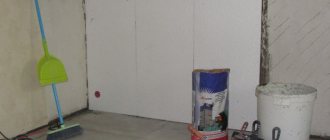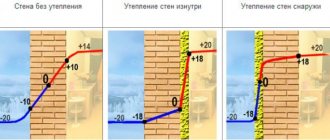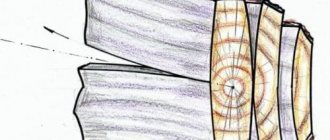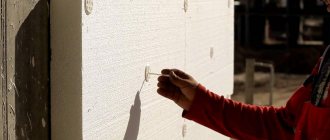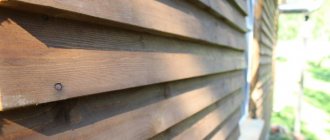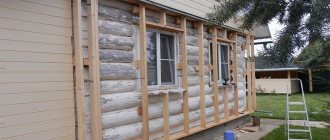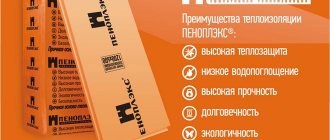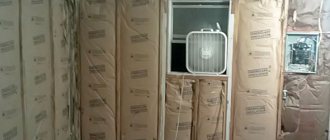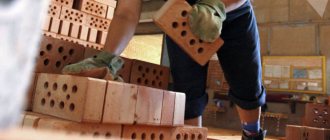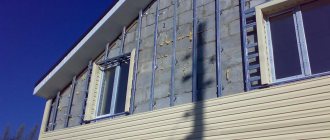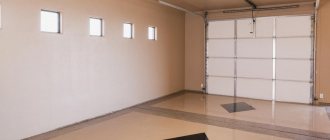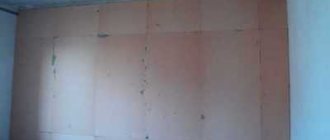Most people feel comfortable at 20-23?C. How to insulate the walls of a country house in order to maintain such a temperature regardless of the season and time of day, and also without significant heating costs?
Comparison of materials for heating engineering
The easiest way to solve this problem is directly during construction. However, it is possible to select the optimal insulation option and suitable insulating material for existing buildings. For example, if you need to turn a cold veranda into a warm room suitable for living in winter, or get rid of freezing of walls at sub-zero temperatures and their dampness in the off-season.
Problems with thermal insulation of building envelopes arise in a wide variety of homes. For example, a common problem with brick or ceramic block walls is freezing of the seams. Since the thermal conductivity of masonry mortar is greater than that of bricks or blocks. Foam, gas or cinder blocks with a thickness of 200–400 mm, popular in private construction in central Russia, do not meet the standards for thermal resistance of walls, not to mention thinner products. Houses made of logs and beams can be cold due to too small a diameter/section, insufficient for a specific climate zone, as well as poor-quality roof insulation.
Materials and step-by-step guide for home insulation
What should you consider when choosing insulation material?
When choosing insulation for your home, you need to pay attention to the following indicators:
- Dew point; Vapor permeability of walls.
The dew point is the temperature at which moisture in the air begins to condense into water.
The dew point is located in the wall and can move about it as external and internal temperatures change.
For example, the temperature in the room is 20 degrees (50% humidity), which means the dew point will be 13 degrees (that is, if there is an object in the room with this temperature or lower, condensation will form on it).
The vapor permeability of walls is the function of the material to retain or pass vapor through itself. This helps remove steam (and reduce humidity) from the room.
For maximum effective insulation you need:
Try to insulate from the outside (if you insulate from the inside, the wall will still remain cold, it just doesn’t let the cold into the room).
And in winter, a wall with internal insulation may completely freeze (especially in the corners).
If you are going to make a “pie” from different insulation materials, then you need to select it in such a way that the vapor permeability increases from the inside to the outside.
Thin and even thinner
LOGICPIR foil insulation boards
When comparing the thermal conductivity parameter of various insulating materials, it turns out that insulation made of rigid polyurethane foam (PIR) has the lowest thermal conductivity - λ = 0.022 W/(m•K). Often, PIR boards with a thickness of only 30 mm can create the necessary comfort.
As for the thickness of other insulation, the minimum thickness of mineral insulation is 50 mm. For expanded polystyrene slabs, this parameter is really small and starts from 20 mm, but the thermal conductivity coefficient is on average λ = 0.034 W/(m•K).
Note that the cost of PIR boards is higher than other types of insulation. Thus, a package of Logicpir slabs (TECHNONICOL Corporation) measuring 1190×590×30 mm (8 pcs.) costs 2164 rubles. But the competitiveness of the latter is explained by their high efficiency.
Foil vapor barrier, bonded to insulation at the factory, provides the best tightness, comparable only to the tightness of glass
Problems
This method has a number of disadvantages. It is for this reason that the method has many opponents. Insulating walls from the inside can cause the following problems:
- The walls are not protected from the cold. The supporting structure of the building continues to be in contact with the outside air. This can lead to its gradual destruction. Cracks will begin to appear on the surface. This measure not only does not protect the outer wall from the cold, but also takes away some of the heat from it, because before insulation, part of the heat from the room heated the wall, but now this flow is blocked.
- Condensation. It forms on a cold surface upon contact with warm air. Heating engineers call the place where condensation forms the dew point. The main task of thermal insulation is to move the dew point outside the wall. Insulation “from the inside” ensures that the dew point shifts to the boundary between the wall and the insulation. This process is hidden, so home owners do not notice it. But humidity will be an excellent condition for the proliferation of various microorganisms.
- Reducing the area of premises. Modern types of insulation have good efficiency. But science has not yet come up with such a good material that its thickness is minimal. To insulate a house from the room side, you will need 5 to 10 cm of insulation. This eats up the area quite a lot. This is not so noticeable to the eye, but if you calculate the losses for the entire building, the figure turns out to be significant.
With internal insulation, the dew point shifts to the boundary between the wall and the insulation.
Therefore, before deciding on internal insulation of the walls of the house, we recommend that you carefully think about the listed problems. In this case, ignorance does not exempt from responsibility, since the result of inattention will make itself felt in the first years of operation.
Liquid thermal insulation
Polyurethane foam
PPU insulation meets all requirements for vapor barrier, water absorption and absence of seams. Therefore, even if there is a dew point inside the layer, it will remain “conditional”, since there is no condensation in vapor-tight materials. This results in a completely sealed thermal insulation layer from the room side.
The environmental friendliness of polyurethane foam after hardening meets the requirements for residential premises. Harmful fumes are present only when the components are mixed during the spraying process - after polymerization, the structure of the material remains stable.
Apply thermal insulation between the sheathing and cover it with moisture-resistant sheet materials (gypsum plasterboard, OSB or plywood). Essentially, it's like a large prefabricated sandwich panel.
The disadvantage of this method is the use of special equipment.
Liquid ceramics
This is a relatively young thermal insulation material, the action of which is based on the use of two principles - the creation of a thin layer with high resistance to heat transfer and the reflection of heat towards the radiation source.
Of course, a thin thermal insulation layer cannot provide good thermal insulation - this is an auxiliary, but mandatory factor. Although it gives a fairly high effect - the wall becomes much “warmer” to the touch.
The main task of reducing heat loss is performed by microscopic ceramic spheres that reflect infrared radiation.
According to the manufacturers, the effect of a 1.5 mm layer can be compared with thermal insulation with 5 cm thick foam plastic or 6.5 cm mineral wool.
The application method is the same as for acrylic paint (the base is the same). After polymerization, a dense and durable film is formed on the surface, and latex additives improve waterproofing properties.
How to insulate walls outside
Preparing the wall surface
Laying expanded polystyrene or polystyrene foam is carried out according to the same principle as for internal insulation.
Preparing the wall surface consists of two stages: cleaning and priming. Wall cleaning is usually used in panel houses in which the surface of the slabs was painted and over time the paint began to peel off. Also, it is recommended to clean the wall if the so-called “fur coat” was applied to it - a decorative insulating layer, which over time began to crack and crumble. When the surface of the wall is cleaned, we prime it and wait for it to dry completely. Please note that insulation work should be carried out in dry and windless weather, at temperatures from +5 to +30 degrees.
Laying insulation
When the wall surface is ready, we proceed to the procedure for installing the thermal insulation material. Laying the insulation begins from the top, in horizontal rows. Fastening of polystyrene foam or expanded polystyrene is also carried out using fungi. Please note that the insulation sheets must extend at least 5 cm beyond the level of the seams of the panel slabs if you live in a panel house - this is necessary in order to insulate the seams. If you live in a brick house, then the insulation should extend beyond the perimeter of your apartment from the outside. At the locations of the windows and at the ends of the rows, we cut the insulation to the required sizes. To attach the insulation, about 5 fungi are used per sheet.
Finishing work
Unlike internal insulation work, for external insulation work, finishing work is carried out somewhat differently. First of all, the seams of the insulation joints are sealed with polyurethane foam; for this, some installers make special grooves in these places in order to seal these seams well. When the mounting foam has dried, cut it off.
Next, using masking tape, we finish the seams; this must be done so that cracks do not form in this area. To do this, apply a thin layer of adhesive mixture and then embed masking tape into it. After finishing the seams, we move on to finishing the entire area of the insulation. To completely finish the surface of the insulation, we need an adhesive mixture and a painting mesh, do not confuse it with masking tape. This procedure is carried out in the same way as for internal insulation: an adhesive mixture is applied to a small area of the insulation, in which the painting mesh is embedded. It is better to apply the mixture in small sections so that it does not dry out while you are busy with the previous section. Next, we install a stainless steel canopy to ensure water drainage. To prevent moisture from remaining on the surface of the insulation, it is advisable to make the canopy at an angle of 45 degrees so that the water flows down.
To give it a beautiful look, it is recommended to paint the surface in any color you like, using paint for exterior use.
External insulation methods
Professional builders and finishers distinguish the following methods for external installation of heat-insulating raw materials:
- Wet type. The sheets are fixed to the external walls and then plastered.
- Finishing of load-bearing structures with 3 non-ventilated layers: the first is heat-insulating material, the second is an air cushion, the third is a decorative base (brick, sandwich, etc.).
- Ventilated facade. Wind protection is attached to the installed insulation elements, after which siding or other finishing raw materials are fixed.
Proper internal insulation of walls in a house or apartment
There are only two ways to insulate indoor walls from the inside and avoid problems with dampness:
- recreating a multi-layer wall (place a half-brick wall with insulation at some distance);
- Heat the wall and then insulate it.
These options work, but, as you can see, they “eat up” a significant amount of space and cost a lot of money. In each specific case, it is necessary to consider what kind of insulation and how much is needed, but the wall pie remains the same.
Second wall
At some distance from the main wall, a second wall 10-12 cm thick is installed. Between the two walls, a layer of insulation, which is required for these conditions, is attached to the inner one. In this case, there should be a ventilation gap of at least 3 cm to the outer wall. In total, this entire structure will be 20-25 cm away from the main wall. It will “eat up” a considerable area.
Options for insulating walls from the inside
As you can see, in this case the dew point can be located inside the insulation or on the inner surface of the wall facing the street. To be able to remove the formed moisture, you can make forced ventilation by installing one or two exhaust fans.
Since in this case the insulation will get wet, it is necessary to choose one that is not afraid of moisture. These are polyurethane foam, polystyrene foam, foam glass. You can also use some types of stone wool, but only those that are not afraid of moisture (there are some).
Thermal insulation material must be fastened simultaneously with the construction of the walls. They laid it out to a certain height and secured the thermal insulation. It’s inconvenient to work, but there is no other choice.
Electrical heating
The idea of this method is to move the dew point inside the wall when insulating a concrete or brick wall internally. To do this, it must be heated. The easiest way is to attach an electric heated floor mat. At some distance from it, insulation is installed, on top of which there is a finishing layer.
How to insulate a wall in an apartment from the inside
In this case, there are no problems with moisture removal, and much less space is required to install the system: from 8 cm (with a ventilation gap of 3 cm and an insulation thickness of 5 cm).
With this method, the thermal insulation material can be of any kind. To install it, first a sheathing is made, then a counter-lattice, and then a suitable insulation is attached to it.
Rolled thermal insulation
Penofol
Penofol is a combination of polyethylene foam and aluminum foil. This is a whole series of materials (including single-sided, double-sided, laminated, with an adhesive layer). Moreover, it can be used both in combination with other heat-insulating materials, and independently. By the way, penofol is popular for insulating a bathhouse from the inside, and there is much more steam there than in an ordinary living room.
To insulate a cold wall, use penofol with one layer of foil (one-sided) and up to 5 mm thick.
In the case, as with liquid ceramics, the effect is achieved due to the low thermal conductivity of foamed polyethylene, as well as its low vapor permeability and high reflective properties of foil (up to 97%).
But unlike seamless coatings, complete sealing and prevention of cold bridges cannot be achieved. Consequently, condensation may form on the surface of the foil. Even the obligatory sealing of the joints with adhesive aluminum foil will still leave gaps inside between adjacent sheets.
The traditional method of combating the formation of condensation on foil is lathing with a ventilated gap between the penofol and the outer cladding.
Polyph
Another version of foamed polyethylene, but already made in the form of a kind of wallpaper - there is a layer of paper on both sides. Polyfoam and is intended for gluing wallpaper onto it.
Of course, its thermal insulation properties are not as high as those of penofol, but they are quite sufficient to make a cold wall feel warmer to the touch.
In most cases, the insignificant thickness of the insulation does not lead to the dew point moving to the inner surface.
The disadvantage of this method is that only a dry wall is insulated.
Comparative analysis of insulation inside and outside
High-quality insulation of walls, foundation and ceiling will make it possible to maintain good conditions in the house. You have to choose between two installation methods for thermal insulation materials:
External insulation - installed on the outer part of the building, its advantages include:
- protection of the surface from the influence of atmospheric conditions, extending the service life;
- the dew point remains on the outside of the room and the walls are not covered with condensation;
- heat supply costs are significantly reduced;
- the internal area of the house remains unchanged;
- a large number of thermal insulators create a layer of sound insulation and reduce the level of penetrating noise;
- there is an opportunity to adjust the architectural image of the house to your own taste.
Among the bad qualities:
- high price of materials;
- The thermal insulation process depends on the weather - work cannot be performed at low temperatures or during rain.
Insulation inside - installed inside
Houses.
This option has a lot of negative factors, but it provides a temperature increase in the room by a couple of degrees. Thermal insulation is installed inside
in several cases:
- if access to the surface from the outside is difficult (high-rise buildings);
- you need to preserve the appearance of the house’s exterior, for example, wood decor.
Disadvantages of insulation inside:
- the required area is lost;
- condensation will appear between the wall surface and the heat insulator at the dew point, provoking the growth of fungus and mold;
- the walls are not protected from the influence of the external environment, they freeze and become unusable.
A comparison demonstrates that external insulation is better than internal insulation. It more effectively maintains high temperature and optimal moisture, increases the service life of load-bearing structures. Thermal insulation placed inside
, loses on all counts, not counting the ability to do it whenever you want. But you cannot refuse it; for most owners of living space and houses, this is the only option to reduce heat loss.
Current repairs are preventive, prevent wear of structures and eliminate minor damage
Disputes about what is current and what is major repairs of the common property of an apartment building are a typical situation today. Owners, management organizations and regional operators for major repairs are constantly finding out who, what and for what money should repair apartment buildings, especially in old housing stock.
The Ministry of Construction of the Russian Federation, in letter No. 7026-AS/08 dated February 27, 2018, tried to distinguish between the concepts of two repairs of common property:
- The current one is the elimination of minor faults identified during the daily operation of the house, in which the element practically does not go out of service, its technical characteristics do not change.
- Capital is the restoration of the lost original technical characteristics of the house element as a whole, while its main technical and economic indicators remain unchanged.
According to clause 18 of RF PP No. 491, current repairs are considered preventive and consist of systematically carried out work by the management authority to prevent wear of structures, as well as work to eliminate minor damage and malfunctions.
Despite the many definitions of current and major repairs, disputes on this issue between the management authority, the owners and the bodies of the State Housing Authority do not stop. For example, we talked about a case in which the question was considered whether the repair of the blind area of a house is a major overhaul or is carried out at the expense of the current one.
Today we are looking into the question of what to include insulating the façade of an apartment building.
How and with what to insulate the walls of a house outside
Let's look at external insulation in more detail.
First of all, we inspect our wall, check the finishing layer for strength (ideally, you need to completely remove the finishing).
We completely prepare the wall for insulation (you can follow the advice above). That is, we clean the previous coating, seal the cracks, and prime it.
After this, you need to select and purchase insulation.
The most commonly used material is expanded polystyrene (foam).
Advantages of polystyrene foam:
- Good thermal insulator; Mold and mildew very rarely form on it; Low price; Long service life; Withstands temperature fluctuations well.
Do not forget that before insulation the wall needs to be leveled; large differences greatly spoil the future appearance of the facade.
Installation of insulation
The polystyrene foam has been selected and purchased, now we need to install it (in addition, we bought glue and cement - we will lay insulation on this).
The glue must be diluted with water until the consistency of plaster is obtained and applied to the wall with a spatula.
Along the lower border of the foam sticker we install a bar along which we will line up the panels.
First we spread it on the wall, then we cover the panels with a small layer and apply it to the wall (lightly pressing it against the wall).
After this, we additionally secure the foam sheets with “umbrellas” (you can also secure them with “umbrellas” a few days after gluing).
Then we cover the joints and caps with glue (if the gaps are large, then we first blow them out with construction foam).
Place a mesh on top, apply a cement mixture to the mesh (try to glue the mesh gradually, in parts).
After the solution has hardened, use a float and sandpaper to sand the surface, removing roughness and unevenness.
After this, we apply the last layer - the finishing mixture. After it dries, we also sand the surface with sandpaper.
What is “dew point” and why measure it?
From the school curriculum, many people know about the boiling point and freezing point of water. These two indicators are not subject to changes in the air and are constant. The dew point is an unstable value. It determines whether the house will get wet during the cold season or remain dry in severe frosts.
The dew point is the point on the thermometer scale at which the surrounding air turns into moisture. Knowledge of this indicator is necessary for many construction works - insulating walls, laying floors, etc. The value of the dew point depends on five factors:
- humidity outdoors and indoors;
- air temperature outside and at home;
- thickness of walls and insulation;
- selected insulating material;
- places where the insulation will be located.
Ideally, the dew point should be as different as possible from the room temperature. The closer these indicators are to each other, the higher the risk of moisture formation on the walls. If the installation of insulation was carried out incorrectly, the owners will regularly encounter damp walls, mold and mildew. With external insulation, the likelihood of condensation appearing on the insulator is minimal.
Proper insulation of the house outside and inside
What do you need to know first about home insulation?
At the moment, there are two main types of insulation:
External - installed on the outer part of the wall and is exposed to weather conditions (but does not take up the space of the rooms) and internal - which are attached to the inside of the wall (it is better to use in large rooms, since during installation the insulation eats up about 10-15 cm from all sides).
Of course, there are still debates and discussions about the best type of insulation (insulate the outside, the inside, or both the outside and the inside). A lot has already been said about this; each option has its own advantages and disadvantages.
On a note
The issue of distinguishing between current and major repairs of individual parts and elements that are part of the common property of owners in apartment buildings is still controversial and is often resolved in court.
RF PP No. 491 and No. 290, Rules No. 170 include insulation of part of the facade of an apartment building and restoration of its thermal protection to the list of works that the management organization must carry out as part of ongoing repairs. Judicial practice often adheres to this position.
However, if the owners decide to insulate the facade as part of a major overhaul, then they can include such work in the list and approve it at a general meeting, provided that:
- the capital repair fund for apartment buildings is formed on a special account,
- or such work is included in the regional overhaul program.
Owners also have the right to decide to collect targeted contributions for insulation of the façade of an apartment building. If they demand that the management company perform such work at the expense of the payment for the maintenance of housing and the case goes to court, the judge may side with the owners.
What is the best way to insulate walls inside a house or problems when insulating houses from the inside
Now it’s worth considering possible insulation problems
When insulating from the inside:
It is important to lay the insulation tightly and fit the drywall tightly. If you leave space or unsealed cracks, cold will seep through them with the onset of cold weather. Also make sure that the temperature of the load-bearing walls does not fall below the dew point, otherwise condensation will form, which may subsequently freeze (cracks will appear) Well, moisture is fungus and mold. How to get rid of these problems?
How to get rid of these problems?
Fasten the insulation tightly to the wall (it is better to use insulation with aluminum foil).
It is better to install not one layer of drywall, but several. So, all insulation work can be done with your own hands and this does not require special knowledge or special tools.
Externally, insulation is more beneficial both from the point of view of preserving space and from the point of view of preserving heat.
The question of proper home insulation is always relevant for regions with harsh climatic conditions.
High-quality thermal insulation reduces heating costs in winter and maintains normal room temperature in summer. If the need for insulation is beyond doubt, then when choosing where to place it, difficulties arise. Having studied the pros and cons of external and internal thermal insulation, you can confidently judge their effectiveness.
conclusions
When deciding whether it is better to insulate the walls of a house outside or inside, you cannot focus only on price. The most affordable, of course, is polystyrene foam, which also retains heat well. However, it cannot be used to insulate houses made of breathable materials, and when burned it emits dangerous fumes.
When choosing, you must take into account the wall material:
- for wooden houses - fiber insulation;
- for brick and concrete - polymer materials;
- for porous walls (aerated concrete or foam blocks) - mineral or stone wool.
The problem of insulating a house must be solved individually, taking into account the characteristics of the house, as well as your personal desires and capabilities.
When ordering the construction of a house from the Render House company, you do not have to choose the material yourself. Our specialists will offer the most suitable option.
Insulation inside, how to avoid condensation
When it is not possible to make thermal insulation from the outside, it is installed inside. The first task is to avoid the occurrence of condensation and moisture harmful to materials. Why do water droplets appear on the surface of the wall? This occurs when cold material comes into contact with warm steam from the room. In order for the wall to remain dry, it must be insulated from steam penetration. To do this you need:
- use a heat insulator with low vapor permeability; it will be better if its value is less than near the wall;
- make high-quality plasterboard cladding that is moisture-resistant;
- apply a waterproofing sheet during installation of the heat insulator;
- reduce indoor humidity using ventilation.
When choosing a thermal insulation material, you need to focus on vapor-resistant products: foamed polymer, extruded polystyrene foam, artificial latex. Possible application min. cotton wool, but its installation will require considerable effort:
- the waterproofing on the wall should be strengthened;
- make a wooden frame from bars impregnated with an antiseptic or a zinc profile;
- put mineral wool, preferably with a layer of foil glued on;
- make a vapor barrier;
- install plaster cladding.
Extruded polystyrene, which consists of polyethylene foam and aluminum-based foil, can be used as a vapor barrier material. The canvases are laid end to end and fixed with brackets; in the connecting places they are coated with glue and foil tape.
Artificial latex is an artificial two-component composition sprayed onto the wall surface. It is moisture-resistant, steam-resistant, and creates a monolithic surface without cold bridges. The heat insulator is used for any type of surface and resists energy loss well. A layer of material 5 cm thick is considered practical. From the side of the room it is covered with a plasterboard partition. The disadvantage of this method is the high cost of services for applying artificial latex.
Foamed polymer and extruded polystyrene foam are more often used than other thermal insulators for wall thermal insulation inside
. The work is divided into a couple of stages.
- We prepare the surface, including removing outdated finishes, cleaning and priming with an antifungal agent.
- On insulating boards, the adhesive composition is applied over the entire surface, and not pointwise as on the outside.
- To ensure good adhesion of materials to the wall surface, the surface of the foamed polystyrene is pierced with a roller with needles.
- The glue needs to be quite strong to fill in small imperfections. The plates are pressed tightly against the wall. Installation is carried out end-to-end.
- After the glue has dried, after 3-4 days, the fastening is increased with umbrella dowels.
- The joints of the plates are finished with polyurethane foam.
- Using glue, a reinforced mesh
. Plaster is applied on top of the dried layer.
Having compared the two methods, we can safely say that insulation from the outside is more advisable. It significantly reduces heat loss and protects the walls of the house from premature destruction.
Review of thermal insulation materials
Each product has its own distinctive features and requires knowledge of the nuances during installation.
Due to the abundance of relevant raw materials, it is necessary to know the strengths and weaknesses of each representative, as well as the subtleties of work.
Cellulose
On the shelves of construction stores, such material is often called ecowool. This circumstance is due to the composition of the product.
80% cellulose consists of recycled paper impregnated with boric acid and flame retardants.
Despite the low thermal conductivity, this raw material easily absorbs moisture, which, coupled with improper installation, significantly reduces its properties.
In addition, cellulose is a fairly loose material, which has a detrimental effect on the service life.
Polyurethane foam
The presented type is produced in liquid form and has a chemical composition similar to foam rubber.
Due to the absence of joints, polyurethane foam forms a single thermal insulation contour that reliably penetrates any surface.
Having resistance to the influence of insects and rodents, all the positive properties of the named material are achieved by following application technology, which is not always possible to comply with.
Mineral wool
On the shelves of modern construction stores you can find many varieties of this raw material.
Depending on the derivative base, mineral insulation materials are divided into representatives produced on the basis of:
- Stone. The insulation is made on the basis of basalt, granite and other solid materials and is a favorite among the available lines. Despite the presence of phenol, such products are recognized as the most environmentally friendly.
- Slag. Such raw materials contain metallurgical waste. Due to its short service life, such a product finds its application in insulating sheds or other outbuildings.
- Glass. Such products are produced by melting glass residues, soda, limestone, dolomite and other materials.
Due to their resistance to fading, these representatives are used in the construction of wood structures.
When purchasing mineral wool, you should be guided by the main rule - the sheets must be dense, without damage to integrity, with a mandatory moisture-proof impregnating layer.
If the above conditions are met, the installed material ensures optimal circulation of steam and air masses without internal accumulation of moisture.
Styrofoam
At its core, it is a plastic mass in a foamed state. The density of polystyrene foam is lower than that of the original raw material, because its main volume is gaseous matter.
Polystyrene foam sheets have a number of features:
- fragility;
- susceptibility to moisture absorption and absorption of sunlight;
- absolute isolation from air and steam penetration;
- cheapness;
- resistance to cold;
- ease of installation.
Categorically not suitable for cladding houses in rural areas. This is due to the fact that rodents can grow in the material.
Penoplex
Experts have varied opinions about this material.
One of the arguments in favor of the fact that raw materials should in no case be used for facade insulation is that due to the presence of a polymer film on the surface of penoplex, difficulties arise when treating the surface with finishing compounds, and a greenhouse effect appears in the house.
The listed negative effects are minimized by installing a ventilation system.
The positive aspects of the material include safety for household members, strength, low thermal conductivity, resistance to microorganisms and moisture penetration, as well as an impressive service life.
Insulation from the inside, how to avoid condensation
When it is not possible to install thermal insulation from the outside, it is installed from the inside. The main task is to avoid the appearance of condensation and moisture that is harmful to materials. Why do water drops appear on the wall?
This occurs when cold material comes into contact with warm steam from the room. In order for the wall to remain dry, it must be insulated from steam penetration. To do this you need:
- use insulation with minimal vapor permeability, it is desirable that its value be lower than that of the wall; perform high-quality finishing from moisture-resistant plasterboard; use waterproofing fabric when installing insulation; reduce the humidity in the room using ventilation.
When choosing a material for thermal insulation, it is worth focusing on vapor-tight products: polystyrene foam, extruded polystyrene foam, polyurethane foam. It is possible to use mineral wool, but its installation will require a lot of effort:
- it is necessary to fix the waterproofing to the wall surface; make a frame from wooden blocks impregnated with an antiseptic, or a galvanized profile; lay mineral wool, preferably with a glued layer of foil; perform a vapor barrier; install plasterboard trim.
Penoplex, consisting of foamed polyethylene and aluminum foil, can be used as a vapor barrier material. The canvases are laid end-to-end and fastened with staples; at the joints they are taped with foil tape.
Polyurethane foam is a synthetic two-component composition sprayed onto the wall. It is moisture-resistant, vapor-tight, and creates a monolithic surface without cold bridges. Insulation is used for any surface and effectively resists energy loss. A layer of material 5 cm thick is considered effective.
From the side of the room it is closed with a plasterboard partition. The disadvantage of this method is the high cost of services for applying polyurethane foam. Polystyrene foam and extruded polystyrene foam are more often used than other insulation materials for thermal insulation of walls from the inside. The work is divided into several stages. Preparation of the surface, including removal of the old finish, cleaning and priming with an antifungal agent. On insulation boards, glue is applied over the entire surface, and not pointwise as on the outside. For better adhesion to the wall, the surface of the polystyrene foam is pierced with a needle roller. There must be enough glue thick to fill small irregularities. The slabs are pressed tightly against the wall.
The installation is carried out end-to-end. After the glue has dried, after 3-4 days, the fastening is reinforced with umbrella dowels. The joints of the plates are treated with polyurethane foam. Using glue, a reinforcing mesh is attached to the surface of the insulation. Plaster is applied over the dried layer. Having compared the two methods, we can confidently say that external insulation is more appropriate. It significantly reduces heat loss and protects the walls of the house from premature destruction.
https://youtube.com/watch?v=6KlLQrO5-IUrel%3D0%26controls%3D0%26showinfo%3D0
- shop.rockwool.ru
- dachnoe-delo.ru
- remontami.ru
The management authority is obliged to carry out routine repairs, even if there is a need for major
According to Part 1 of Art. 166 of the Housing Code of the Russian Federation, the list of works on major repairs of the common property of an apartment building includes facade repairs. In some regions, the authorities supplement this list and include their insulation as part of the repair of house walls, as, for example, they did it in St. Petersburg. On the contrary, the government in the Samara region decided to exclude such work from the list of major repairs due to their high cost.
But in this case we are talking about a major overhaul of the entire facade of the apartment building. If a separate section of the wall/room needs insulation, then work to restore the thermal protection is the responsibility of the management organization, which is provided for by RF PP No. 290. This position is confirmed by the practice of the RF Armed Forces, which indicated that the need for major repairs does not stop the responsibility of the organization’s managers to carry out routine repairs for restoration of the proper condition of the common property in the house (determinations dated August 21, 2019 No. 302-ES19-13268, dated August 27, 2019 No. 307-ES19-14880).
Such conclusions are also made by lower courts, for example, in case No. A17-6634/2017. If, during the inspection of the common property, the management office has determined that in order to eliminate the detected defects it is necessary to carry out major repairs, this circumstance does not exempt it from ongoing work on the repair of such elements until the moment when the owners make a decision on major repairs.
Insulation of the foundation from the inside
Before insulating the base of a building from the inside, you should carefully prepare the insulated surface:
- seal cracks, holes, crevices;
- apply a layer of frost-resistant waterproofing;
- wrap it in a layer of vapor barrier, permeable only from the side of the house.
After the preparation has been completed, you can begin to select the insulating material and installation technology. There are three main types of insulation:
- expanded clay;
- backfill soil;
- foam panels.
The most affordable and easy to implement options are soil and expanded clay. They should be poured into the sinuses of the foundation. The only drawback of this type of insulation is that it will be impossible to inspect or repair the subfloor. It should also be taken into account that the implementation of bulk thermal insulation is possible only in the open base of the building, without a basement.
The panel insulation procedure is performed as follows:
- glue the panels or strengthen them with thermal dowels;
- Fill the resulting seams with foam;
- stretch a reinforcing mesh made of fiberglass onto the panel;
- To increase the fire resistance of the finish, a layer of plaster should be applied over the mesh.
Naturally, this method of insulating the foundation from the inside is quite expensive, but much more effective.
The final stage is ventilation of the subfloor. To do this, it is necessary to leave vents (through holes) located on the same axis in the foundation wall. In winter, the holes must be sealed, and in warm periods they must be opened so that the condensate that has accumulated over the winter comes out of the underground.
Thermal insulation of a timber or wooden house
Stage 1
Insulation of wooden houses begins with sealing all cracks. The presence of cracks in the logs indicates that the wood is dry and well-seasoned. You also need to caulk the gaps between the logs themselves.
What can be used:
- classic tow based on jute, moss, flax, hemp;
- wood glue mixed with sawdust and wood dust (for small cracks);
- mastics and sealants;
- polyurethane foam (large gaps).
The packaging of the sealant should say “Frost-resistant”. Silicone and acrylic are not the most suitable options.
It is better to caulk the gaps between the logs using classical methods, hammering in the tow with a mallet and chisel.
You need to caulk the cracks during construction, then repeat the procedure a year later, after shrinkage. And in subsequent years, after 5 - 10 years.
Stage 2
A wooden frame of such thickness is attached to the log base that will correspond to the calculated thickness of the insulation.
The choice of insulation usually comes down to two options:
- Mineral wool.
- Expanded polystyrene (Penoplex, for example).
Expanded polystyrene is more expensive, a 10-centimeter layer of it has the same properties as 16 centimeters of mineral wool, it is more moisture-resistant, but...
For cladding the walls outside of a wooden house, mineral wool is more suitable, since wood must breathe and be ventilated, and the vapor permeability of expanded polystyrene is very weak.
Stage 3
Next, a windproof membrane is attached to the frame. This is a special porous material that releases steam outside, but does not allow it to penetrate inside. Not plastic film!
Now another sheathing is being made, which will provide a ventilation gap.
And finally, a layer of finishing. This could be Block House, siding, flat slate, lining, etc.
Requirements for insulation
To choose the right insulation for external or internal insulation, you need to take into account its characteristics and operating conditions.
Thermal conductivity
. The lower the thermal conductivity coefficient of the insulation, the better it will retain heat in the house and the thinner its layer can be. However, in general, the thickness of thermal insulation is calculated based on the region, the thickness and materials of the walls and some other parameters. Many modern insulation materials, for example, mineral wool, polystyrene foam, and penoplex, have low thermal conductivity.
Flammability
. This parameter shows how the material behaves under the influence of open fire. For example, mineral wool is a non-combustible material, and polystyrene foam changes its structure during a fire (see figure below).
Water absorption coefficient
. The lower this indicator, the more the material is protected from moisture absorption.
Vapor permeability
. This characteristic shows how much the material is capable of transmitting air and steam. For example, mineral wool has a high vapor permeability of 0.49-0.6 mg/m*h*Pa, while for foam plastic this parameter is 0.03 mg/m*h*Pa.
Environmental friendliness
. Studying the composition of insulation and its effect on health is especially important when it comes to interior decoration.
Density
. The higher this parameter, the more weight the entire structure will have.
There are other characteristics of insulation that may be important when solving a specific problem. In general, to protect the wall from the outside, the insulation must have a low thermal conductivity coefficient, weakly absorb moisture and not be flammable. For interior walls, environmental friendliness of materials also plays an important role.
Thermal insulation of ceiling and floor
If you choose a method of insulation at the construction stage, then there are more options. You can perform bulk insulation (from expanded clay, for example), lay tile insulation, or spray polymers.
A double floor system is often performed, when a subfloor is constructed, a thermal insulator is laid (poured, sprayed, etc.) on it, and then a vapor barrier and a finishing layer are made.
More modest choice of options for the finished floor. Here, roll insulation materials are used (cork, isolon, penofol, flax, mineral wool, etc.), which are rolled out over the subfloor and covered with a finishing coating. A more labor-intensive method, used where there is non-residential space under the floor, is to add heat insulation from the bottom of the floor.
Ceiling insulation option
Do the same with the ceiling. The ceiling located between two living rooms is best hemmed from below, and if there is an attic space, the ceiling is insulated by filling the space between the joists from above. Ecowool is well suited for these purposes.
Foam is not recommended for floors due to its low density, and for ceilings due to its fire hazard. Extruded polystyrene foam improves in both of these areas, but before using it, it is better to study all the characteristics and weigh the pros and cons.
